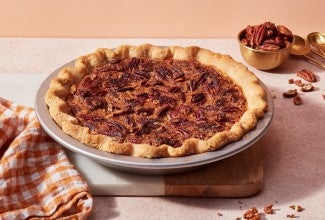How to make your best Thanksgiving pies
Tips for success with all of your Thanksgiving pies, from pumpkin to pecan.


Thanksgiving is stressful. The prep, the cooking, and all those dirty dishes … it’s enough to overwhelm even the best planner. And then there's the desserts. More specifically, the Thanksgiving pies.
I sat down and talked to one of our King Arthur bakers specialists about the #1 reason each of the most popular Thanksgiving pies fail — and how to remedy the issue.
The creamiest chocolate cream, an apple pie that will be remembered for years to come — they really are possible. Just take a deep breath and read on.

Apple Pie is one of America’s most iconic desserts. It also seems to be one of the most stressful to make. Our Baker’s Hotline gets so many calls from home bakers with apple pie anxiety. The most common question: Is the first cut going to reveal a soupy mess?
First off, as tempting as it may smell, waiting until any and all pies have fully cooled will go a long way to ensuring a set filling.
The type of thickener you use also really makes a big difference in the search for the perfect pie. Our Pie Thickener Chart is a handy tool to have whenever you bake. Some prefer cornstarch, others like flour, but just know that the thickener can be easily swapped out of your recipe.
I personally prefer Pie Filling Enhancer in my apple pies. The blend of thickener, superfine sugar, and ascorbic acid really brightens up my flavors, as well as giving me the perfect thickness. But again, refer to our chart and figure out what you prefer.

You mixed and prepped and poured your Pumpkin Pie perfectly. Phew.
But, darn it — it cracked when you pulled it from the oven. Sure, whipped cream could cover it up well enough, but we know you crave perfection. So what to do?
Pumpkin pie filling is basically a custard; the eggs in the filling will continue cooking as the heat from the edge of the pie moves toward the center, which is why it's important to remove the pie from the oven before the center is completely set. Leaving it in the oven too long will cause the eggs to overcook, tightening the proteins and causing the pie to crack in the center.
Another option? Use your instant-read thermometer to take the pie’s temperature at its center (which will still look quite soft). It should be about 175°F (for a softer pie) to 180°F (for a firmer one).
So don’t throw this baby in the oven and run off to the store. Timing truly is key.

Chocolate Cream Pie is a holiday favorite. Because chocolate.
So yes, you will definitely still eat it, even if it comes out like soup in a crust — but you shouldn’t have to!
Once you add the eggs and cream, you want to make sure you cook the filling enough to thicken the mixture. You want a thick layer to stick to the back of the spoon when dipped. Any sooner, and the filling won't set, resulting in a chocolate-y soup.
And while we're here, let's talk about whipped cream. Is anyone confused about how long to beat it? My fellow blogger MaryJane wrote a terrific post about how to perfectly whip cream. It's worth a read!

People seem to have great success with baking their pecan pie. They know to take it out while the center has a bit of a wobble, but is no longer liquid — resulting in the perfect pie when fully cooled.
What they do have an issue with is all of the corn syrup used in the filling. Some can't live without it; others ... can. For those with that issue, we suggest you give our Old-Fashioned Pecan Pie a try. This classic dessert uses brown sugar and a longer bake time to thicken and flavor this buttery-sweet pie.
Another option would be the use of cane sugar instead of corn syrup. Lyle's Golden Pecan Pie is a King Arthur favorite, and we know you and your family will love it as well.

I know I already covered Apple Pie, but our bakers just have so many questions. So one more: why the huge gap between the top crust and filling?
Making a mile-high apple pie requires a lot of apples — but the thing about apples is they cook down. And the top crust typically bakes and sets in place before the filling cooks down, leaving behind a bit of empty space. So what to do?
Try slicing your apples thinner. That way you have more apples in the filling and those thinner slices have less room to shrink.
If you’re worried about those thin slices turning your pie into apple sauce, try switching your apples up to firmer ones like Granny Smith or Gala. They’ll hold their shape better in the oven. Thinner sliced apples also make for an easier time slicing your pie. A win/win/win? We think so!
Thanksgiving doesn’t have to be stressful, truly. With these pie tips, we’re hoping that at least the dessert will be easy-peasy. And as always, give our friendly Baker’s Hotline a call with any baking questions. They’ve heard it all, so they’ve got all the answers!
Cover photo by Rick Holbrook; food styling by Kaitlin Wayne.


